|
|
||||||||||||||||||||||||||||||||||||||||||||||||||||||||||
|
Please sign my Guestbook and leave feedback |
||||||||||||||||||||||||||||||||||||||||||||||||||||||||||
|
Recent Additions |
||||||||||||||||||||||||||||||||||||||||||||||||||||||||||
|
I am hoping by now that I have convincingly established that in a very small area of the East Midlands the carving of decorative cornice friezes on churches was something of a local “thing”. I think I have also firmly established that one man - the Gargoyle Master - had sculpted at nine of these churches at least. So far we have not discussed the much more meaty topic of the friezes themselves. Common sense would tell you that if we can identify a corpus of work by a gargoyle sculptor we ought to be able to do the same for one or more men carving the cornice friezes. Indeed, this study, as we have seen, began with the identification of a man who had carved at both Ryhall and Oakham churches in Rutland. A previous map showed some twenty-five churches that have extensive friezes or that have gargoyles carved by the Gargoyle Master. This narrative will concern itself principally - but not exclusively - with a subset of those churches where we can see the sculpted work of not only the Gargoyle Master but of up to four other masons besides. Those churches are mainly defined by one or both of two iconic carvings - the “mooning” man and the “flea”. We have already met the mooning men, noting that Oakham Church has no fewer than three. That church is, however, but one of eleven within this confined area. A second image recurs at seven of these eleven churches. It is a matter of debate what the sculptors intended them to be but my own guess is that it is was a flea. Mediaeval people were plagued by fleas and yet could not see what they actually looked like as they were too small. Those locations with flea carvings are marked with an asterisk in the list below. So eleven churches are linked by the remarkable ubiquity of two very specific carvings. All of the churches in the list below have a mooning man carving and those marked * also have a flea. All but three - Hungarton, Exton and Cottesmore - have already been identified as stamping grounds of the Gargoyle Master. Although no two images are identical, all are of the same basic design. Ryhall, ironically, has neither. Its link to Oakham, however, is incontrovertible so in all this is a group of twelve churches that are apparently artistically linked to each other. Things are further complicated by the church at Harlaxton that has a flea but no mooning man but I will be addressing that apparent anomaly later. I have named the whole group that has one or more of mooner, flea carving or gargoyles by the “Master” as “Mooning Men Group” of churches, or “The MMG”. I have also included Ryhall, making fourteen in all. |
|
|
* A Minor Frieze (as defined by myself) is one that is on the tower only. |
|
Thus we have three features linking fourteen churches and this obviously cannot be coincidence. Nor can it reasonably be said that it is just a matter of local fashion, especially when the gargoyles are so clearly by one man. Let’s take a look at those mooners. |
 |
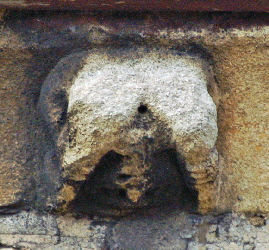 |
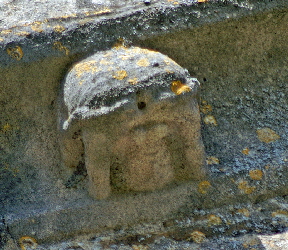 |
||||||||||||||||||||||||||||||||
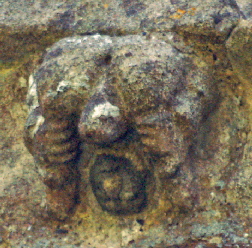 |
||||||||||||||||||||||||||||||||||
|
Mooning Men at (Left to Right): Exton, Cottesmore South Aisle, Langham, Tilton-on-the-Hill |
||||||||||||||||||||||||||||||||||
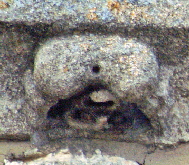 |
 |
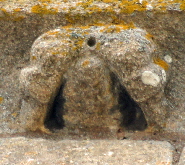 |
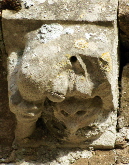 |
|||||||||||||||||||||||||||||||
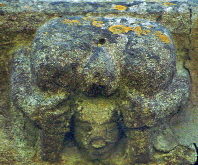 |
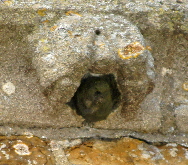 |
|||||||||||||||||||||||||||||||||
|
Mooning Men at (Left to Right): Cottesmore South Aisle; Cottesmore North Aisle; Hungarton, Buckminster (damaged), Lowesby, Knossington |
||||||||||||||||||||||||||||||||||
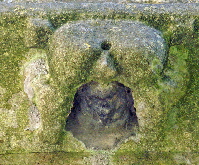 |
||||||||||||||||||||||||||||||||||
 |
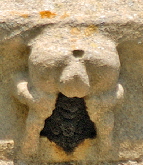 |
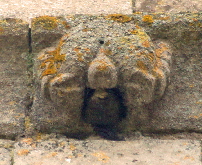 |
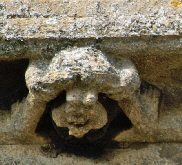 |
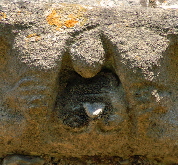 |
||||||||||||||||||||||||||||||
|
Mooning Men at (Left to Right): Oakham North Aisle, Oakham South Porch, Wymondham, Whissendine, Tilton-on-the-Hill |
||||||||||||||||||||||||||||||||||
|
Most habitual church visitors will have their personal collection of photographs of “rude” stone carvings. Many a book has been spawned by them, many a theory put forward to explain, them. Into this bucket we must put priapic men, exhibitionist women (the Sheela-na-gigs), bum scratchers and face pullers. You might spend days trying to find even one if you look randomly but they are now so well documented that they are airily – and erroneously – dismissed as commonplace. They only seem so if you know where to find them. In my extensive travels around the churches of Cumbria, for example, I cannot recall one example. Now let’s have a look at the fleas. . |
 |
 |
||||||||||||||||||||||||||||||||
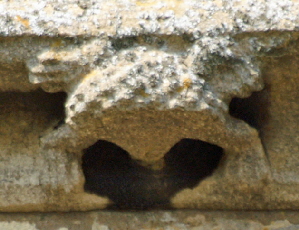 |
 |
||||||||||||||||||||||||||||||||
|
Mediaeval Flea Circus at (Left to Right): Buckminster, Harlaxton, Whissendine, Cottesmore North Aisle |
|||||||||||||||||||||||||||||||||
 |
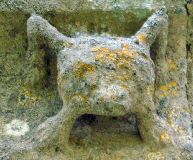 |
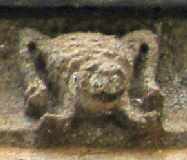 |
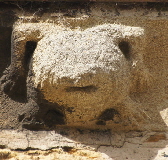 |
 |
|||||||||||||||||||||||||||||
 |
|||||||||||||||||||||||||||||||||
|
Mediaeval Flea Circus at (Left to Right): Hungarton, Oakham, Langham, Exton. Cottesmore South Aisle, Cottesmore South Clerestory |
|||||||||||||||||||||||||||||||||
|
Are they fleas? I have variously speculated that they might be turtles, tortoises, lizards, lice or frogs. Their legs don’t look like any of those creatures. I suggest fleas only on the basis that they were a mediaeval affliction and the legs have an “I’m about to jump” look about them and that they are too small for a mediaeval mason to know what they look like which would explain the absence of a third pair of legs. So fleas for me. You can call them what you like. The Buckminster flea is a particularly vicious-looking specimen, Harlaxton’s looks quite a happy chap. Now there are many “explanations” for exhibitionist carvings floating around. Some are remarkably po-faced and some are remarkably absurd. A mediaeval preoccupation with constipation is the most entertaining I have seen. I suspect that all of the explanations are bunkum. Here, though, we have a plethora of them. We also have a plethora of fleas and there are no rational “explanations” for those. We will see that the friezes do not have many common denominator designs (although we shall be seeing common styles, as we already have at Ryhall and Oakham). Yet here we have two images appearing over and over again. The only rational explanation is that they are “trademarks” or “calling cards” of the stonemasons themselves. The fleas are not as ubiquitous as the mooners. Four churches, all in Leicestershire, have mooners but not fleas. Harlaxton has a flea but not a mooner. remarkably, Whissendine and Cottesmore have a flea and mooner juxtaposed on the south side of the church. The odds against this being coincidence are ridiculous. Moreover, just to confuse things further, the friezes concerned are clearly not by the same man. |
|||||||||||||||||||||||||||||||||
 |
|||||||||||||||||||||||||||||||||
 |
|||||||||||||||||||||||||||||||||
|
The only rational explanation for the ubiquity of these two designs within such a small area is that they were stonemason-led. The notion that a patron or a cleric was demanding such oddities is simply absurd. These are, as we will see, determinedly non-religious friezes. Whatever the friezes were there for it was not for the glory of God. The patrons of the building work must at least, however, condoned them. There would have been plenty of examples in the locality for them to study as has already become obvious. So the rational explanation is that the patrons knew exactly what they would be getting and welcomed it or even demanded it. They would surely have also seen that where these masons carved friezes they also carved mooners and they must then have been comfortable with the notion. And we will see that they were also comfortable with bum scratchers, face pullers and animals playing musical instruments. In short, these friezes were to large extent a no-holds-barred canvas upon which the masons could give free range to their, to our eyes, peculiar imaginations; imaginations, one cannot help but feel, that were in tune with those oft heir patrons and their parishioners. So the mooners and fleas are there because the stonemasons wanted to put them there and nobody was willing or able to veto them. There are literally thousands of frieze carvings and gargoyles to be seen at these churches. Few of them are individually memorable and much fewer still are those that keep recurring. The repetition of the mooner and flea carvings is not coincidence. We will be seeing,, moreover, that the mooners were carved by probably at least three individual masons. We can point to no other device that recurs in this way. The only rational reasons for the stonemasons wanting to put them there is firstly to leave their mark - their trademark - of their collective identity. A their trademark is what you would expect from a bunch of hard-living blokes who worked in an exclusively male environment and who wanted to make their trademark one that would make people sit up. The flea is somewhat less ubiquitous but the same arguments apply that this was also a trademark. The question is whether it was the mark of a subset of the collective it whether it was the trademark of an individual. This will be the subject of some more analysis later in this work but for now it is worth looking again at the above pictures of mooners and fleas juxtaposed at Whissendine and Cottesmore. Now we need to look at another phenomenon - one that we have already encountered within the context of the Gargoyle Master - the constant reappearance of heads framed within square shaped headdresses. Arguably this is the biggest mystery in this group of friezes. We have already seen it appearing on the hitchhiker gargoyles and others by the gargoyle Master. In the next section we are going to see that it is ubiquitous on these churches - both inside and out. |
|||||||||||||||||||||||||||||||||
|
Recommended Next Section: The Square Headdress |
|||||||||||||||||||||||||||||||||
|
Bums and Fleas (You are here!) Church Building in the Post-Plague Era |
|||||||||||||||||||||||||||||||||